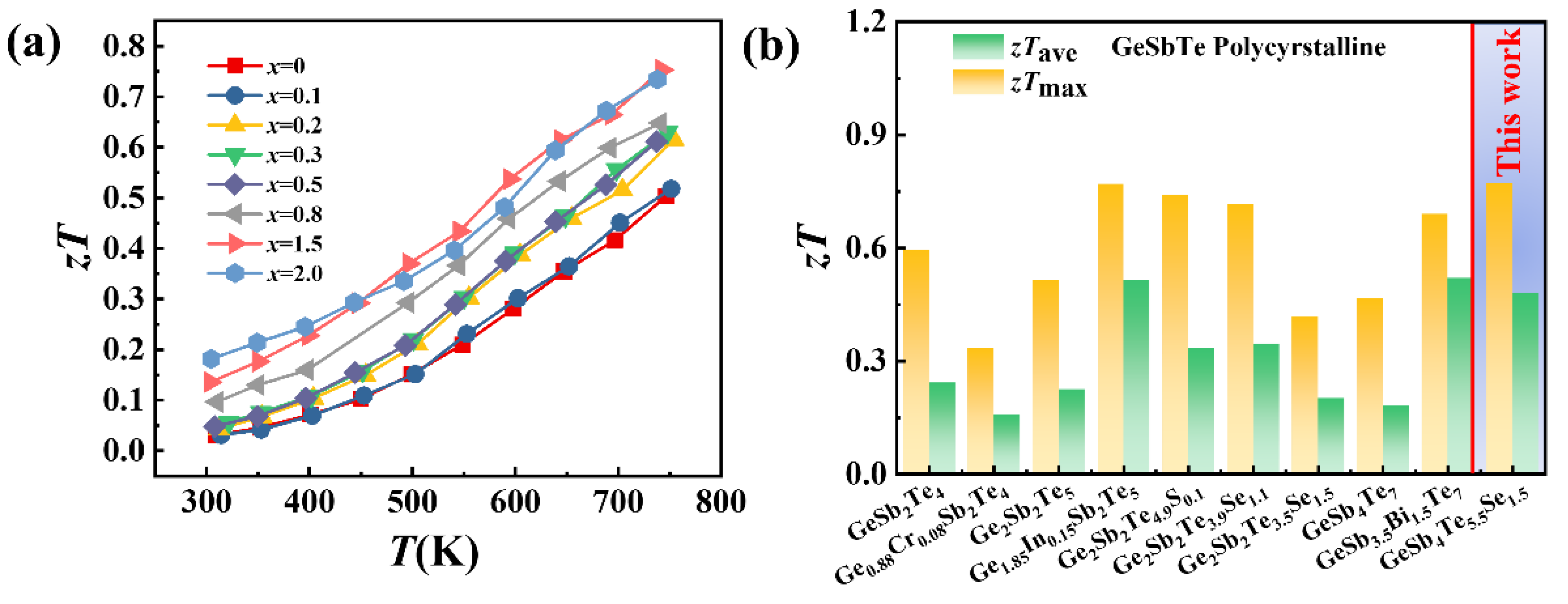Enhancing the Thermoelectric Performance of GeSb4Te7 Compounds via Alloying Se
Abstract
1. Introduction
2. Experimental Methods
2.1. Material Synthesis
2.2. Calculation
2.3. Material Characterization
3. Results and Discussion
3.1. Phase and Crystal Structures
3.2. Raman Measurement and Analysis
3.3. Thermoelectric Properties
4. Conclusions
Supplementary Materials
Author Contributions
Funding
Institutional Review Board Statement
Informed Consent Statement
Data Availability Statement
Conflicts of Interest
References
- Snyder, G.J.; Toberer, E.S. Complex thermoelectric materials. Nat. Mater. 2008, 7, 105–114. [Google Scholar] [CrossRef] [PubMed]
- Shi, X.; Chen, L. Thermoelectric materials step up. Nat. Mater. 2016, 15, 691–692. [Google Scholar] [CrossRef] [PubMed]
- Wu, Y.; Qiu, P.; Yu, Y.; Xiong, Y.; Deng, T.; Cojocaru-Mirédin, O.; Wuttig, M.; Shi, X.; Chen, L. High-performance and stable AgSbTe2-based thermoelectric materials for near room temperature applications. J. Mater. 2022, 8, 1095–1103. [Google Scholar] [CrossRef]
- Qiu, X.; Qiu, P.; Yue, Z.; Chen, H.; Deng, T.; Xiao, J.; Ren, D.; Zhou, Z.; Chen, L.; Shi, X. Phase Transition Behaviors and Thermoelectric Properties of CuAgTe1-xSex near 400 K. ACS Appl. Mater. Interfaces 2022, 14, 1015–1023. [Google Scholar] [CrossRef] [PubMed]
- He, J.; Tritt, T.M. Advances in thermoelectric materials research: Looking back and moving forward. Science 2017, 357, eaak9997. [Google Scholar] [CrossRef]
- Shi, X.; Chen, L.; Uher, C. Recent advances in high-performance bulk thermoelectric materials. Int. Mater. Rev. 2016, 61, 379–415. [Google Scholar] [CrossRef]
- Yang, S.; Gao, Z.; Qiu, P.; Liang, J.; Wei, T.-R.; Deng, T.; Xiao, J.; Shi, X.; Chen, L. Ductile Ag20S7Te3 with Excellent Shape-Conformability and High Thermoelectric Performance. Adv. Mater. 2021, 33, 2007681. [Google Scholar] [CrossRef]
- Shi, X.; He, J. Thermopower and harvesting heat. Science 2021, 371, 343–344. [Google Scholar] [CrossRef]
- Jiang, B.; Yu, Y.; Cui, J.; Liu, X.; Xie, L.; Liao, J.; Zhang, Q.; Huang, Y.; Ning, S.; Jia, B.; et al. High-entropy-stabilized chalcogenides with high thermoelectric performance. Science 2021, 371, 830–834. [Google Scholar] [CrossRef]
- Qiu, P.; Cheng, J.; Chai, J.; Du, X.; Xia, X.; Ming, C.; Zhu, C.; Yang, J.; Sun, Y.-Y.; Xu, F.; et al. Exceptionally Heavy Doping Boosts the Performance of Iron Silicide for Refractory Thermoelectrics. Adv. Energy Mater. 2022, 12, 2200247. [Google Scholar] [CrossRef]
- Zhao, K.; Zhu, C.; Zhu, M.; Chen, H.; Lei, J.; Ren, Q.; Wei, T.-R.; Qiu, P.; Xu, F.; Chen, L.; et al. Structural Modularization of Cu2Te Leading to High Thermoelectric Performance near the Mott-Ioffe-Regel Limit. Adv. Mater. 2022, 34, 2108573. [Google Scholar] [CrossRef] [PubMed]
- Xing, T.; Song, Q.; Qiu, P.; Zhang, Q.; Gu, M.; Xia, X.; Liao, J.; Shi, X.; Chen, L. High efficiency GeTe-based materials and modules for thermoelectric power generation. Energy Environ. Sci. 2021, 14, 995–1003. [Google Scholar] [CrossRef]
- Wei, T.-R.; Hu, P.; Chen, H.; Zhao, K.; Qiu, P.; Shi, X.; Chen, L. Quasi-two-dimensional GeSbTe compounds as promising thermoelectric materials with anisotropic transport properties. Appl. Phys. Lett. 2019, 114, 053903. [Google Scholar] [CrossRef]
- Hu, P.; Wei, T.-R.; Qiu, P.; Cao, Y.; Yang, J.; Shi, X.; Chen, L. Largely Enhanced Seebeck Coefficient and Thermoelectric Performance by the Distortion of Electronic Density of States in Ge2Sb2Te5. ACS Appl. Mater. Interfaces 2019, 11, 34046–34052, Corrected in ACS Appl. Mater. Interfaces 2020, 12, 7854–7854. [Google Scholar] [CrossRef]
- Hu, P.; Wei, T.-R.; Huang, S.-J.; Xia, X.-G.; Qiu, P.-F.; Yang, J.; Chen, L.-D.; Shi, X. Anion-site-modulated thermoelectric properties in Ge2Sb2Te5-based compounds. Rare Met. 2020, 39, 1127–1133. [Google Scholar] [CrossRef]
- Du, W.; Gu, Y.; Wang, K.; Yang, X.; Xing, J.; Guo, K.; Luo, J.; Zhao, J.-T. Effective Mass Enhancement and Thermal Conductivity Reduction for Improving the Thermoelectric Properties of Pseudo-Binary Ge2Sb2Te5. Ann. Phys. 2020, 532, 1900390. [Google Scholar] [CrossRef]
- Chen, P.; Wu, H.; Zhang, B.; Zhou, Z.; Zheng, S.; Dai, L.; Huo, Y.; Zhang, D.; Yan, Y.; Peng, K. Intrinsically Low Lattice Thermal Conductivity and Anisotropic Thermoelectric Performance in In-doped GeSb2Te4 Single Crystals. Adv. Funct. Mater. 2023, 33, 2211281. [Google Scholar] [CrossRef]
- Chen, Y.; Zhang, B.; Zhang, Y.; Wu, H.; Peng, K.; Yang, H.; Zhang, Q.; Liu, X.; Chai, Y.; Lu, X.; et al. Atomic-Scale Visualization and Quantification of Configurational Entropy in Relation to Thermal Conductivity: A Proof-of-Principle Study in t-GeSb2Te4. Adv. Sci. 2021, 8, 2002051. [Google Scholar] [CrossRef]
- Wang, S.; Xing, T.; Hu, P.; Wei, T.-R.; Bai, X.; Qiu, P.; Shi, X.; Chen, L. Optimized carrier concentration and enhanced thermoelectric properties in GeSb4-xBixTe7 materials. Appl. Phys. Lett. 2022, 121, 213902. [Google Scholar] [CrossRef]
- Blöchl, P.E. Projector augmented-wave method. Phys. Rev. B 1994, 50, 17953–17979. [Google Scholar] [CrossRef]
- Perdew, J.P.; Wang, Y. Accurate and simple analytic representation of the electron-gas correlation energy. Phys. Rev. B 1992, 45, 13244–13249. [Google Scholar] [CrossRef] [PubMed]
- Perdew, J.P.; Ruzsinszky, A.; Csonka, G.I.; Vydrov, O.A.; Scuseria, G.E.; Constantin, L.A.; Zhou, X.; Burke, K. Restoring the Density-Gradient Expansion for Exchange in Solids and Surfaces. Phys. Rev. Lett. 2008, 100, 136406. [Google Scholar] [CrossRef] [PubMed]
- Hafner, J. Ab-initio simulations of materials using VASP: Density-functional theory and beyond. J. Comput. Chem. 2008, 29, 2044–2078. [Google Scholar] [CrossRef] [PubMed]
- Parlinski, K.; Li, Z.; Kawazoe, Y. First-principles determination of the soft mode in cubic ZrO2. Phys. Rev. Lett. 1997, 78, 4063. [Google Scholar] [CrossRef]
- Togo, A.; Tanaka, I. First principles phonon calculations in materials science. Scr. Mater. 2015, 108, 1–5. [Google Scholar] [CrossRef]
- López, R.; Gómez, R. Band-gap energy estimation from diffuse reflectance measurements on sol–gel and commercial TiO2: A comparative study. J. Sol-Gel Sci. Technol. 2012, 61, 1–7. [Google Scholar] [CrossRef]
- Sosso, G.C.; Caravati, S.; Bernasconi, M. Vibrational properties of crystalline Sb2Te3 from first principles. J. Phys. Condens. Matter 2009, 21, 095410. [Google Scholar] [CrossRef]
- Cho, Y.; Kang, J.H.; Liang, L.; Taylor, M.; Kong, X.; Ghosh, S.; Kargar, F.; Hu, C.; Balandin, A.A.; Puretzky, A.A. Phonon modes and Raman signatures of MnBi2nTe3n+1(n= 1, 2, 3, 4) magnetic topological heterostructures. Phys. Rev. Res. 2022, 4, 013108. [Google Scholar] [CrossRef]
- Zhao, Y.-F.; Guan, Z.; Zhong, N.; Yue, F.-Y.; Xiang, P.-H.; Duan, C.-G. Raman spectra of bulk and few-layer GeSe from first-principles calculations. Front. Mater. 2021, 8, 736057. [Google Scholar] [CrossRef]
- Zhao, K.; Blichfeld, A.B.; Chen, H.; Song, Q.; Zhang, T.; Zhu, C.; Ren, D.; Hanus, R.; Qiu, P.; Iversen, B.B. Enhanced thermoelectric performance through tuning bonding energy in Cu2Se1–xSx liquid-like materials. Chem. Mater. 2017, 29, 6367–6377. [Google Scholar] [CrossRef]
- Deng, T.; Qiu, P.; Xing, T.; Zhou, Z.; Wei, T.-R.; Ren, D.; Xiao, J.; Shi, X.; Chen, L. A low-cost and eco-friendly Br-doped Cu7Sn3S10 thermoelectric compound with zT around unity. J. Mater. Chem. A 2021, 9, 7946–7954. [Google Scholar] [CrossRef]
- May, A.F.; Snyder, G.J. Thermoelectrics and its Energy Harvesting; Rowe, D.M., Ed.; CRC Press: Boca Raton, FL, USA, 2012; pp. 1–18. [Google Scholar] [CrossRef]
- Liu, J.; Xing, T.; Gao, Z.Q.; Liang, J.S.; Peng, L.M.; Xiao, J.; Qiu, P.F.; Shi, X.; Chen, L.D. Enhanced thermoelectric performance in ductile Ag2S-based materials via doping iodine. Appl. Phys. Lett. 2021, 119, 121905. [Google Scholar] [CrossRef]
- Deng, T.; Wei, T.-R.; Song, Q.; Xu, Q.; Ren, D.; Qiu, P.; Shi, X.; Chen, L. Thermoelectric properties of n-type Cu4Sn7S16-based compounds. RSC Adv. 2019, 9, 7826–7832. [Google Scholar] [CrossRef]
- Chen, R.; Qiu, P.F.; Jiang, B.B.; Hu, P.; Zhang, Y.M.; Yang, J.; Ren, D.D.; Shi, X.; Chen, L.D. Significantly optimized thermoelectric properties in high-symmetry cubic Cu7PSe6 compounds via entropy engineering. J. Mater. Chem. A 2018, 6, 6493–6502. [Google Scholar] [CrossRef]
- Kim, H.-S.; Gibbs, Z.M.; Tang, Y.; Wang, H.; Snyder, G.J. Characterization of Lorenz number with Seebeck coefficient measurement. APL Mater. 2015, 3, 041506. [Google Scholar] [CrossRef]
- Xing, T.; Zhu, C.; Song, Q.; Huang, H.; Xiao, J.; Ren, D.; Shi, M.; Qiu, P.; Shi, X.; Xu, F.; et al. Ultralow Lattice Thermal Conductivity and Superhigh Thermoelectric Figure-of-Merit in (Mg, Bi) Co-Doped GeTe. Adv. Mater. 2021, 33, 2008773. [Google Scholar] [CrossRef] [PubMed]
- Hao, F.; Qiu, P.; Song, Q.; Chen, H.; Lu, P.; Ren, D.; Shi, X.; Chen, L. Roles of Cu in the Enhanced Thermoelectric Properties in Bi0.5Sb1.5Te3. Materials 2017, 10, 251. [Google Scholar] [CrossRef]
- Welzmiller, S.; Schlegel, R.; Pöppl, A.; Bothmann, G.; Scheidt, E.-W.; Scherer, W.; Oeckler, O. Doping GeSb2Te4 with Cr3+: Structure and Temperature-Dependent Physical Properties. Z. Für Anorg. Und Allg. Chem. 2015, 641, 2350–2356. [Google Scholar] [CrossRef]
- Sosso, G.; Caravati, S.; Gatti, C.; Assoni, S.; Bernasconi, M. Vibrational properties of hexagonal Ge2Sb2Te5 from first principles. J. Phys. Condens. Matter 2009, 21, 245401. [Google Scholar] [CrossRef]
- Fang, J.; Wang, J.; Cao, X.; Man, Y.; Liu, C.; Cheng, L.; Zhang, X.; Zhao, H.; Zhang, H.; Li, J. Thickness dependence of a giant nonlinear saturable absorption response in GeSb4Te7 thin films. J. Phys. Commun. 2018, 2, 015009. [Google Scholar] [CrossRef]
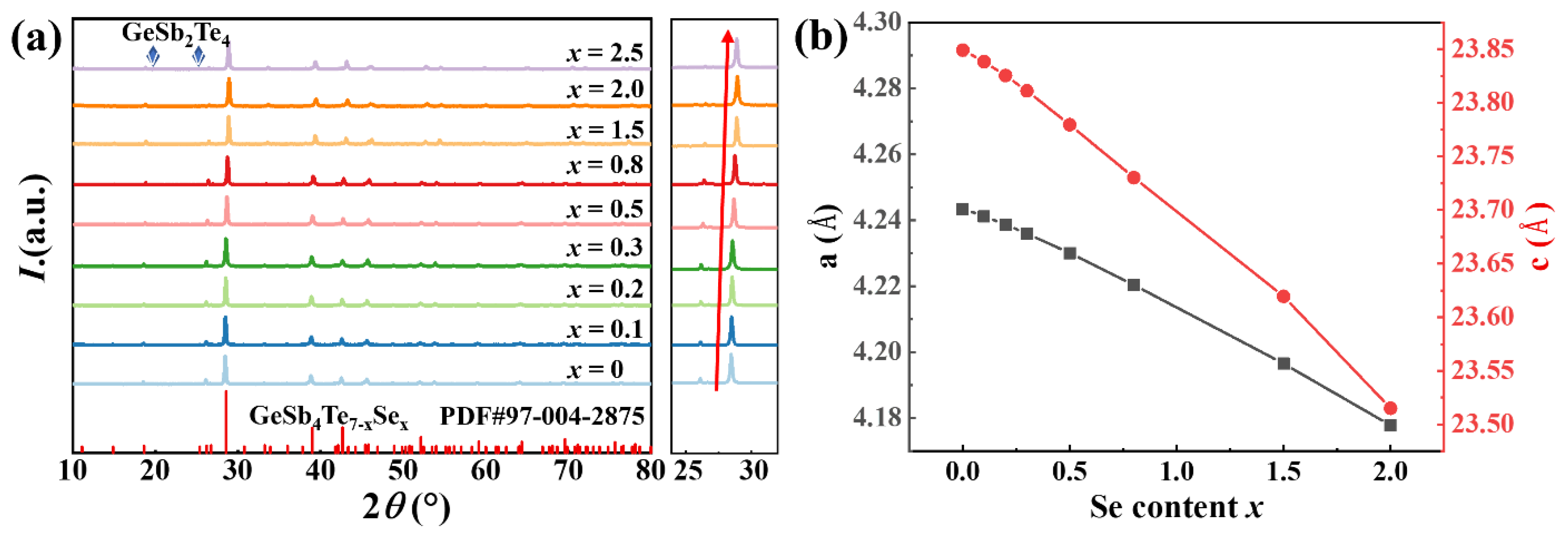
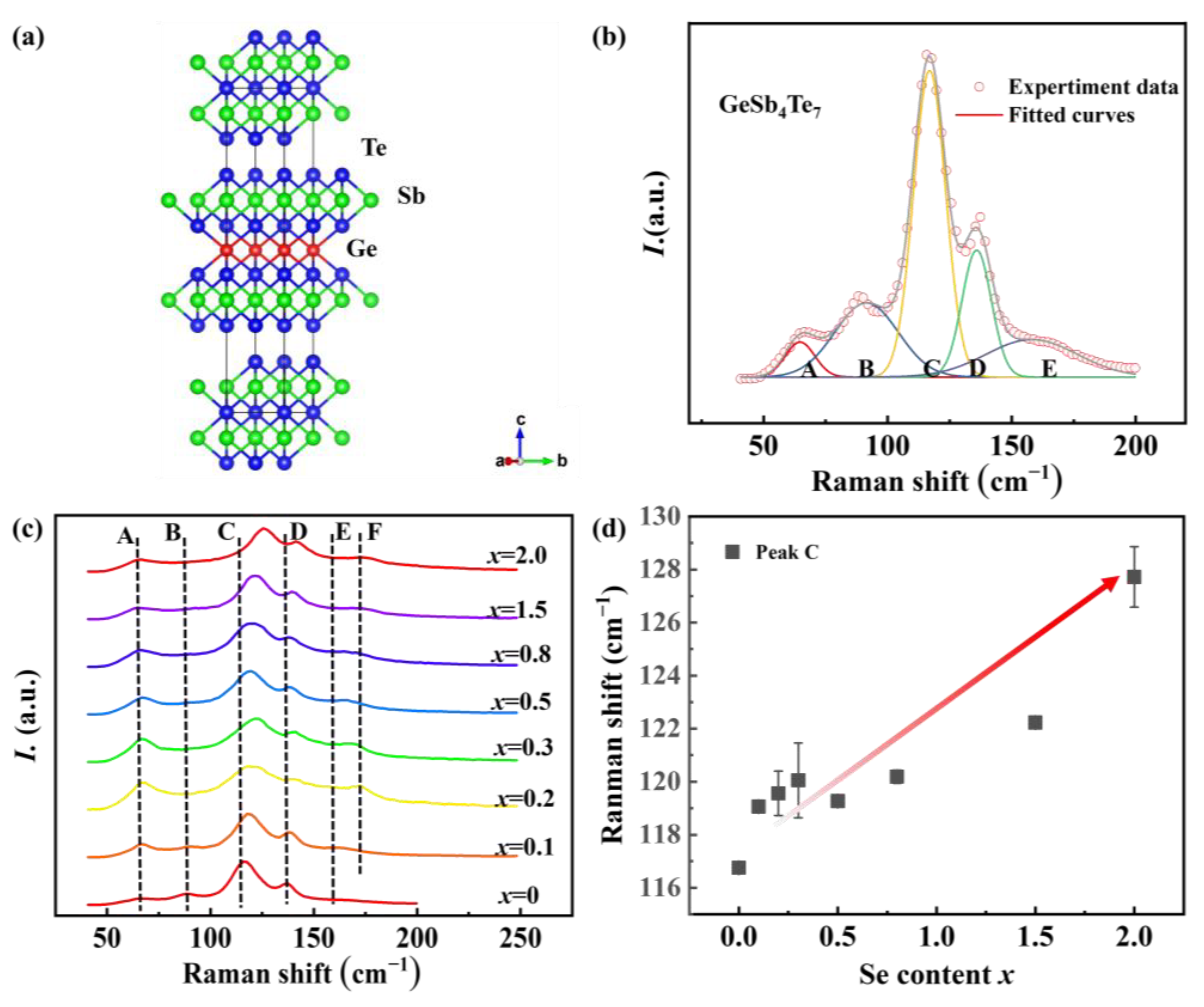

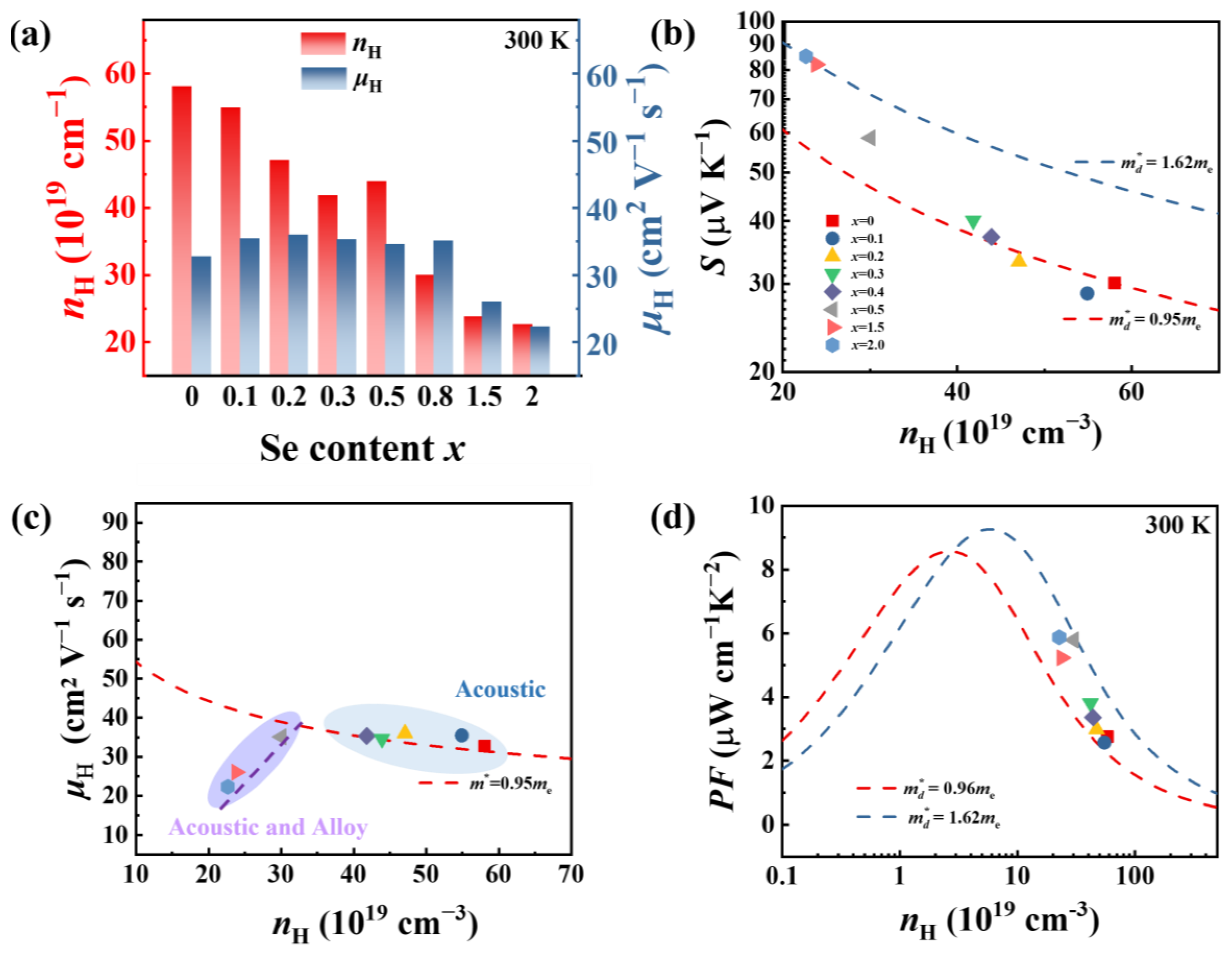
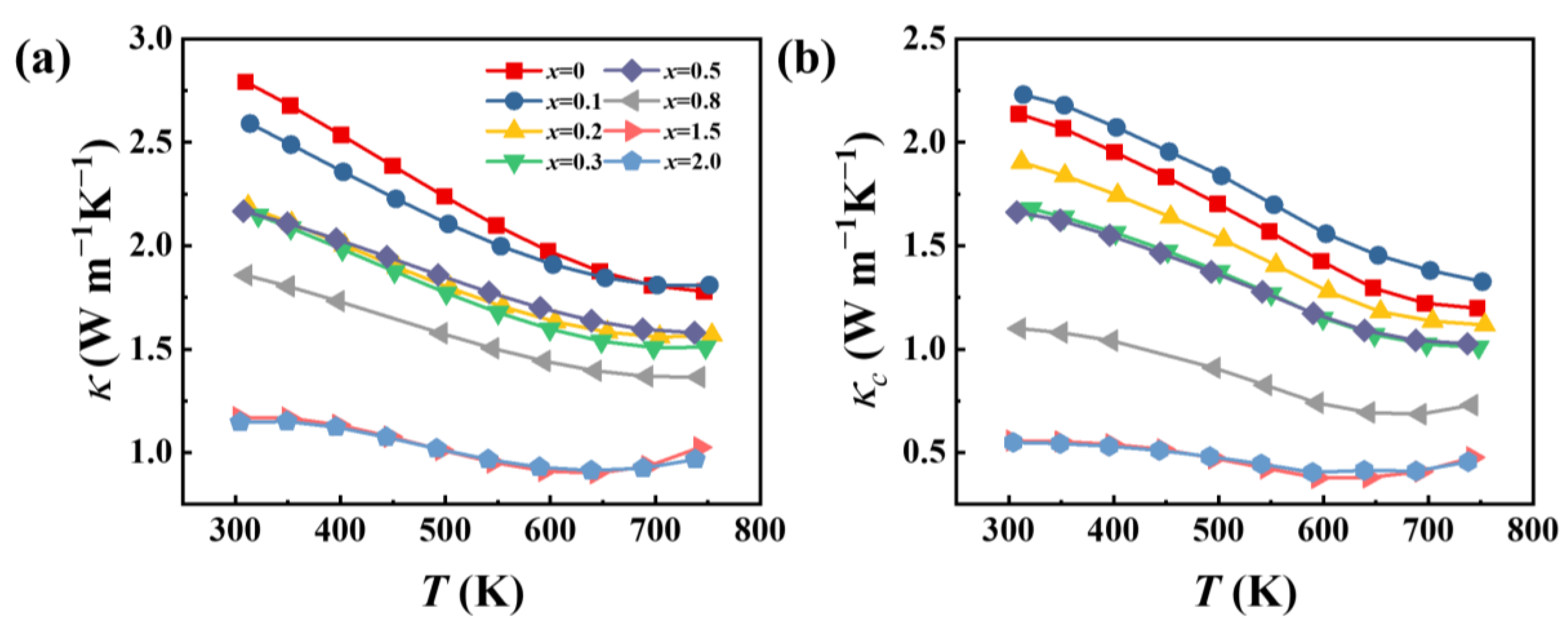
Disclaimer/Publisher’s Note: The statements, opinions and data contained in all publications are solely those of the individual author(s) and contributor(s) and not of MDPI and/or the editor(s). MDPI and/or the editor(s) disclaim responsibility for any injury to people or property resulting from any ideas, methods, instructions or products referred to in the content. |
© 2023 by the authors. Licensee MDPI, Basel, Switzerland. This article is an open access article distributed under the terms and conditions of the Creative Commons Attribution (CC BY) license (https://creativecommons.org/licenses/by/4.0/).
Share and Cite
Wang, S.; Xing, T.; Wei, T.-R.; Zhang, J.; Qiu, P.; Xiao, J.; Ren, D.; Shi, X.; Chen, L. Enhancing the Thermoelectric Performance of GeSb4Te7 Compounds via Alloying Se. Materials 2023, 16, 3368. https://doi.org/10.3390/ma16093368
Wang S, Xing T, Wei T-R, Zhang J, Qiu P, Xiao J, Ren D, Shi X, Chen L. Enhancing the Thermoelectric Performance of GeSb4Te7 Compounds via Alloying Se. Materials. 2023; 16(9):3368. https://doi.org/10.3390/ma16093368
Chicago/Turabian StyleWang, Siyu, Tong Xing, Tian-Ran Wei, Jiawei Zhang, Pengfei Qiu, Jie Xiao, Dudi Ren, Xun Shi, and Lidong Chen. 2023. "Enhancing the Thermoelectric Performance of GeSb4Te7 Compounds via Alloying Se" Materials 16, no. 9: 3368. https://doi.org/10.3390/ma16093368
APA StyleWang, S., Xing, T., Wei, T.-R., Zhang, J., Qiu, P., Xiao, J., Ren, D., Shi, X., & Chen, L. (2023). Enhancing the Thermoelectric Performance of GeSb4Te7 Compounds via Alloying Se. Materials, 16(9), 3368. https://doi.org/10.3390/ma16093368






